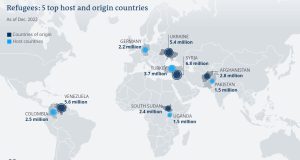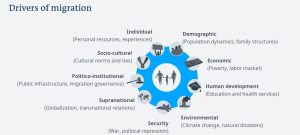The displacement crisis explained in four graphs
Because of war, disasters and economic crises millions of people around the world are forced to leave their homes each year.
These four graphs show who is going where and why, and which countries are taking in refugees.
Where do refugees come from?
The UN refugee agency UNHCR says that currently, of all the refugees under its CR’s mandate and people in need of international protection 52 per cent come from just three countries.
 The majority are from Syria, where the initial uprising during the 2011 Arab Spring evolved into a civil war that continues today.
The majority are from Syria, where the initial uprising during the 2011 Arab Spring evolved into a civil war that continues today.
The second largest national group is 5.7 million people from Ukraine, an end to the Russian invasion of the country is yet to seem likely.
A similar number of people come from Afghanistan. The western-backed government collapsed there in August 2021, seeing the return of extremist religious group, the Taliban.
According to the UNHCR, refugees are persons forced to flee their own countries because their race, religion, nationality, political opinion or membership in social groups leads to persecution; or people who cannot live safe, dignified lives because of conflict.
Missing migrants
 Refugees and migrants often encounter danger on their journey toward a new life. Many suffer hunger, illness or are subjected to violence. And many die along the way.
Refugees and migrants often encounter danger on their journey toward a new life. Many suffer hunger, illness or are subjected to violence. And many die along the way.
According to information from the Missing Migrants Project of the International Organization for Migration (IOM), at least 50,000 people died or were registered as missing between 2014 and 2022.
Factors driving migration
 There are a plethora of reasons why people migrant. The IOM has created a visual representation of the nine most important aspects and factors involved.
There are a plethora of reasons why people migrant. The IOM has created a visual representation of the nine most important aspects and factors involved.
For example, a young person may decide to emigrate because of better job prospects overseas or better educational opportunities.
For the millions of Ukrainians who have left their homeland, , security is the most important factor. They are fleeing the war that Russia is waging in their country.
Environmental conditions can also be a factor triggering migration. Inhabitants of the Global South, who are already struggling to cope with poverty and conflict, are disproportionately affected by extreme weather events such as excessive rainfall, drought and hurricanes.
In 2022, for example, devastating floods forced hundreds of thousands of people in Pakistan to flee their homes. The country was already in a severe economic crisis and has had to rely on international aid to provide for the flood victims, and for reconstruction.
Internally displaced
 The proportion of internally displaced persons is largest by far in Syria, where almost a third of the entire population are refugees in their own land, according to UNHCR.
The proportion of internally displaced persons is largest by far in Syria, where almost a third of the entire population are refugees in their own land, according to UNHCR.
Following Russia’s invasion of Ukraine, around 20 per cent of the population there has been displaced internally. Those countries are followed by Colombia and Yemen with 13 per cent, Afghanistan at 9 per cent, Congo at 6 per cent and Ethiopia at 3 per cent.
These numbers are based on those who have been displaced by conflict and violence. They do not include people displaced internally by climate change and natural disasters.












